The low point was in September, which had spooked the Fed. But that’s over.
By Wolf Richter for WOLF STREET.
The reason we’re looking at the underlying dynamics of the labor market is to gauge the pressure within the Fed to cut interest rates to prevent the labor market from weakening. And in these underlying dynamics, there are no reasons for the Fed to cut interest rates further. The labor market is not weakening, it has been tightening just a little since September. Over the same period, inflation measures have accelerated some. And that combination has caused the Fed to move any rate cuts into the distance, and even Trump suddenly thought that this pivot to wait-and-see “was the right thing to do.”
Job openings, after two months of strong increases, gave up some of those increases in December and fell to 7.60 million, seasonally adjusted, in very squiggly month-to-month data. The low point was in September at 7.37 million openings (blue in the chart below).
The three-month average, which irons out those month-to-month squiggles and shows the trends of the underlying dynamics of the labor market, ticked up for the third month in a row from the low point in September, and even the September low point was still above the prior historic high point in late 2018 (red).
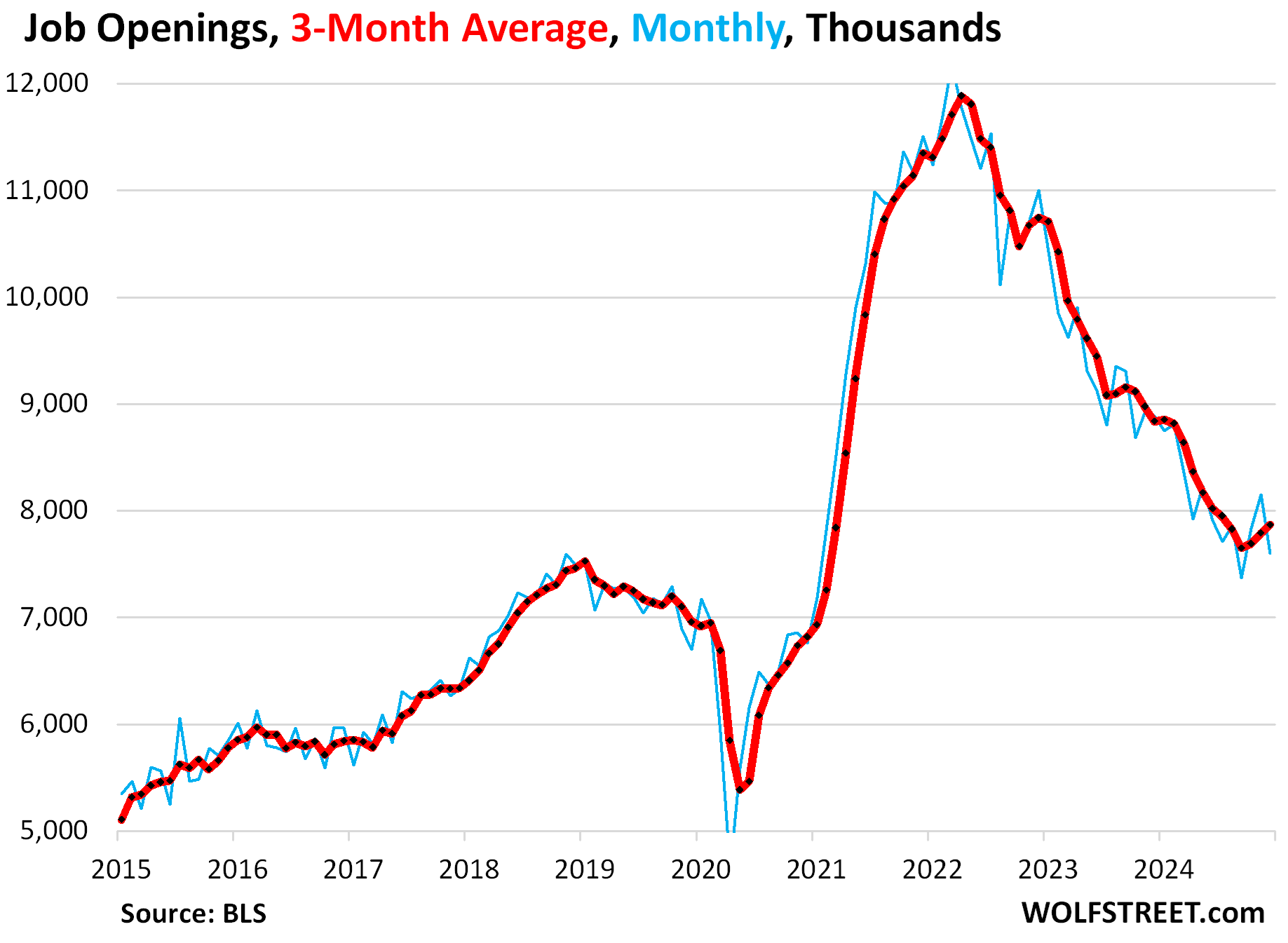
This date from the Job Openings and Labor Turnover Survey (JOLTS) from the Bureau of Labor Statistics today is based on surveys of about 21,000 work locations, and not on online job listings.
Job openings in relationship to nonfarm payrolls ticked up again and is still at levels that had never been seen before the pandemic. In December, job openings amounted to 4.9% of nonfarm payrolls, the third month in a row of increases. This shows that the labor market is still historically tight, though not nearly as tight as it had been during the labor shortages of the pandemic:
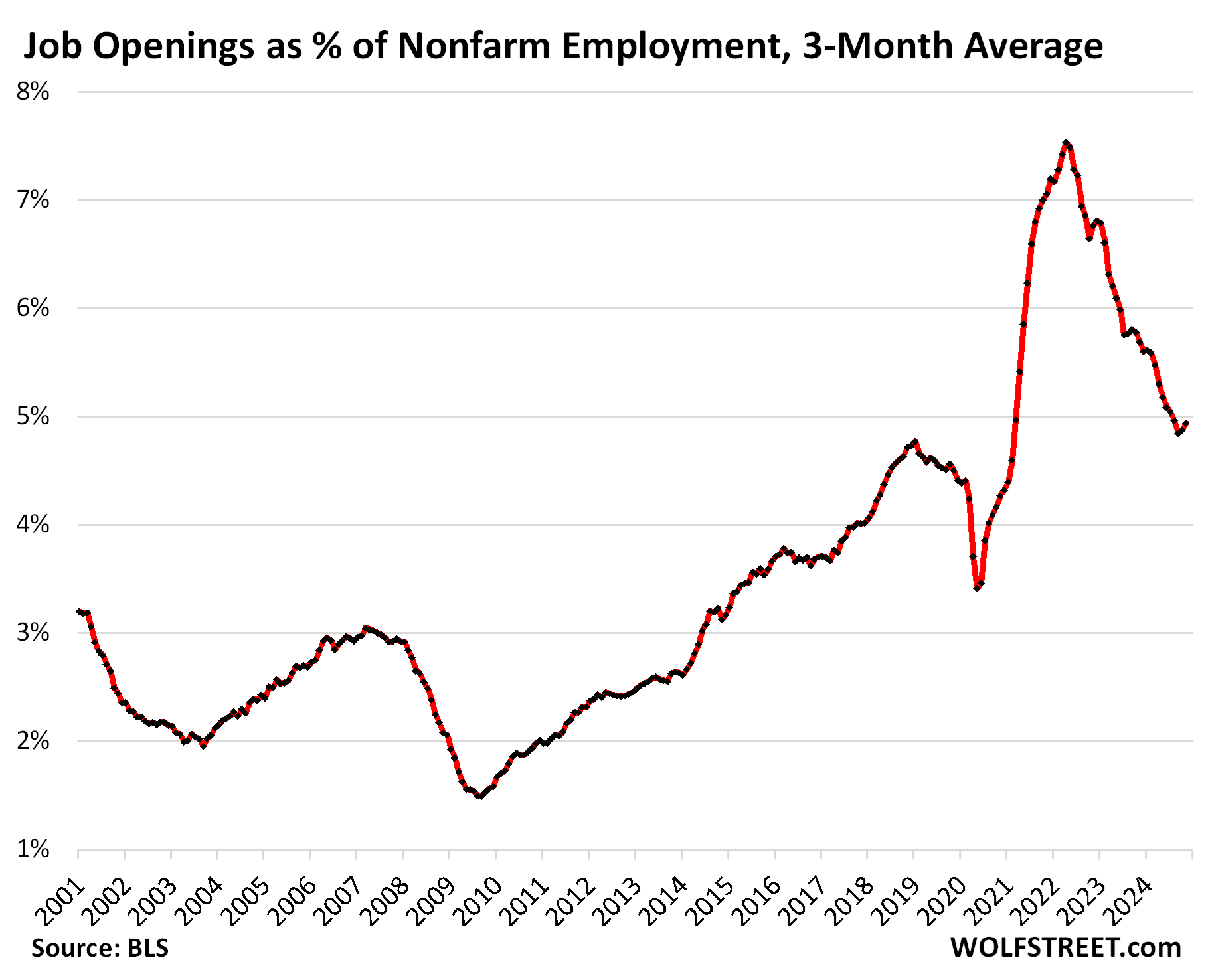
The figure Powell cites a lot: The number of job openings per unemployed person ticked down to 1.10 job openings for each person who was unemployed and looking for a job during the reference period (7.60 million job openings for 6.89 million unemployed people looking for work).
The ratio has remained in that range for the past six months, with a low point in September. It was in September that the Fed got spooked about further deterioration of the labor market. But that didn’t happen.
The ratio is relatively high – meaning a relatively tight labor market – compared to the prepandemic data going back to 2001, where only 2018 and 2019 had a higher ratio.
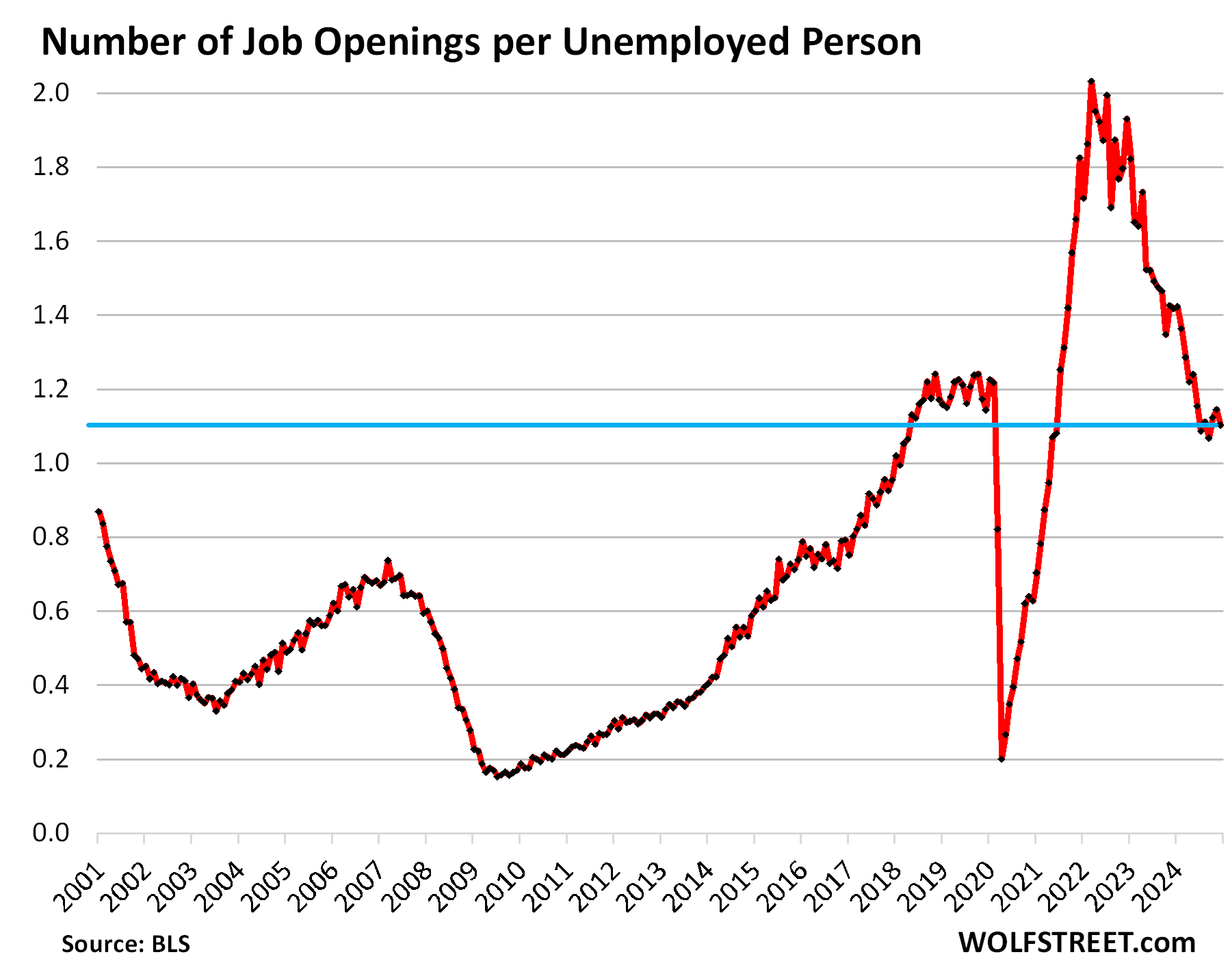
Voluntary quits have also turned the corner. The number of people who quit their jobs voluntarily in December rose to 3.20 million.
The three-month average, which irons out the month-to-month squiggles, rose to 3.20 million as well, the highest since August. This is the first time since the peak in mid-2022 that the three-month average is higher for a four-month period.
Quits are an indication of how emboldened employees feel to quit a job, such as to switch to a better job. Retirements, deaths, etc. are not considered “quits.” They’re categorized as “other separations.”
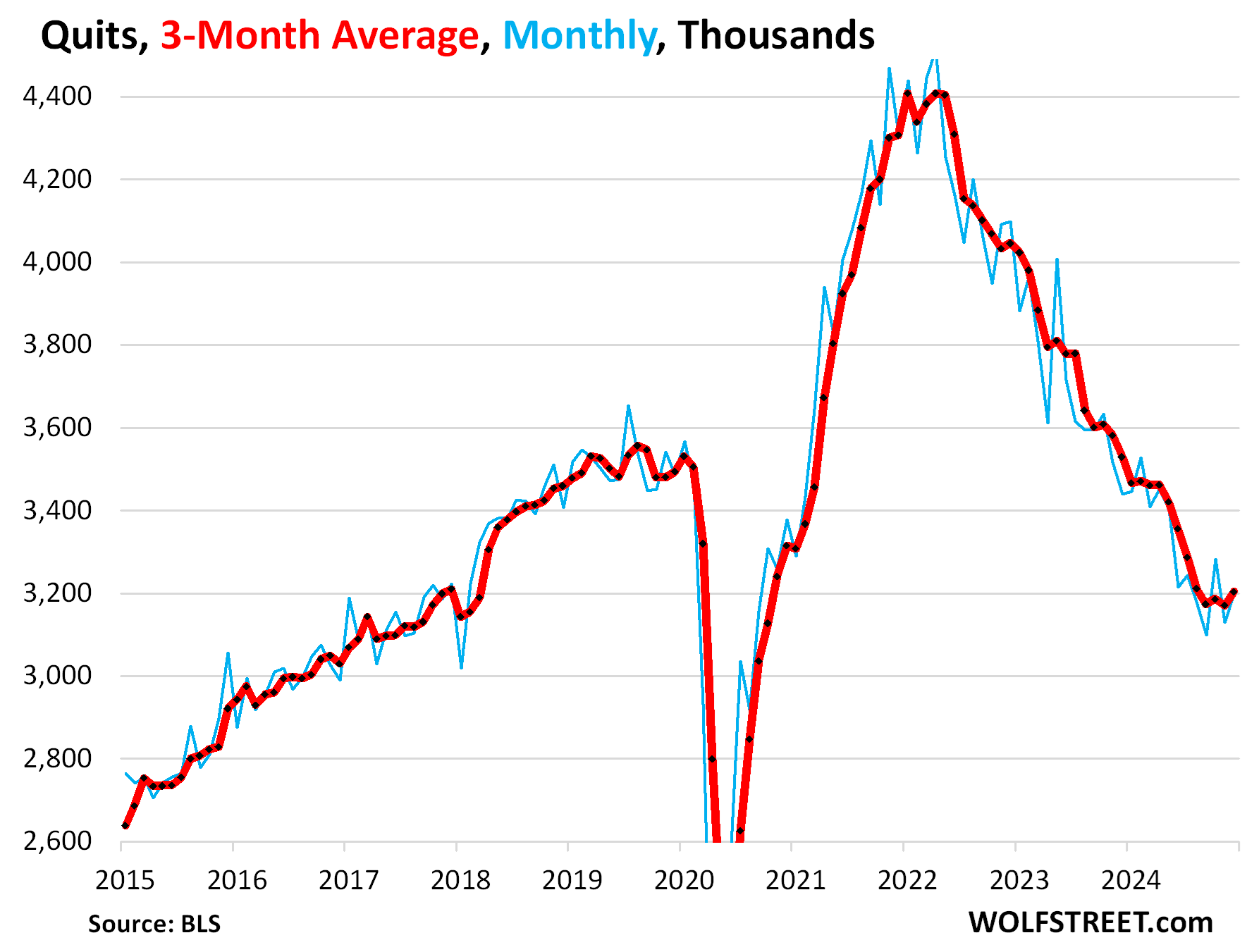
The massive reshuffling in the workforce during the pandemic, when workers quit left and right to get better jobs, even in other industries, had triggered the biggest pay increases in decades as employers tried to retain their workers, or hire new workers to fill the slots that the quits had left behind.
Then the biggest employers cracked down, with huge layoff announcements that spiraled through the media, and some actual layoffs – while still hiring – which had knocked the confidence out of employees, and they put their nose to the corporate grindstone instead of quitting. And quits fell to relatively low levels, which created a lot of stability for companies, and productivity rose. But quits seem to have bottomed out now.
Quits directly impact job openings and hires. Fewer quits mean fewer newly open slots left behind that have to be filled, so fewer job openings, and fewer hires to fill those openings. The cycle of quits, job openings, and hires is just churn.
When the churn began to cool in the second half of 2022, fewer workers quit, so fewer jobs were left behind, and job openings plunged from the pandemic highs, and fewer people needed to be hired to fill those left-behind slots, and so hires plunged along with it. That was just churn, and it has cooled.
Hires to replace workers who quit or were laid off or discharged, and to fill new roles, rose in December after falling in the prior two months. The three-month average ticked down to 5.45 million. The low point was in August at 5.37 million.
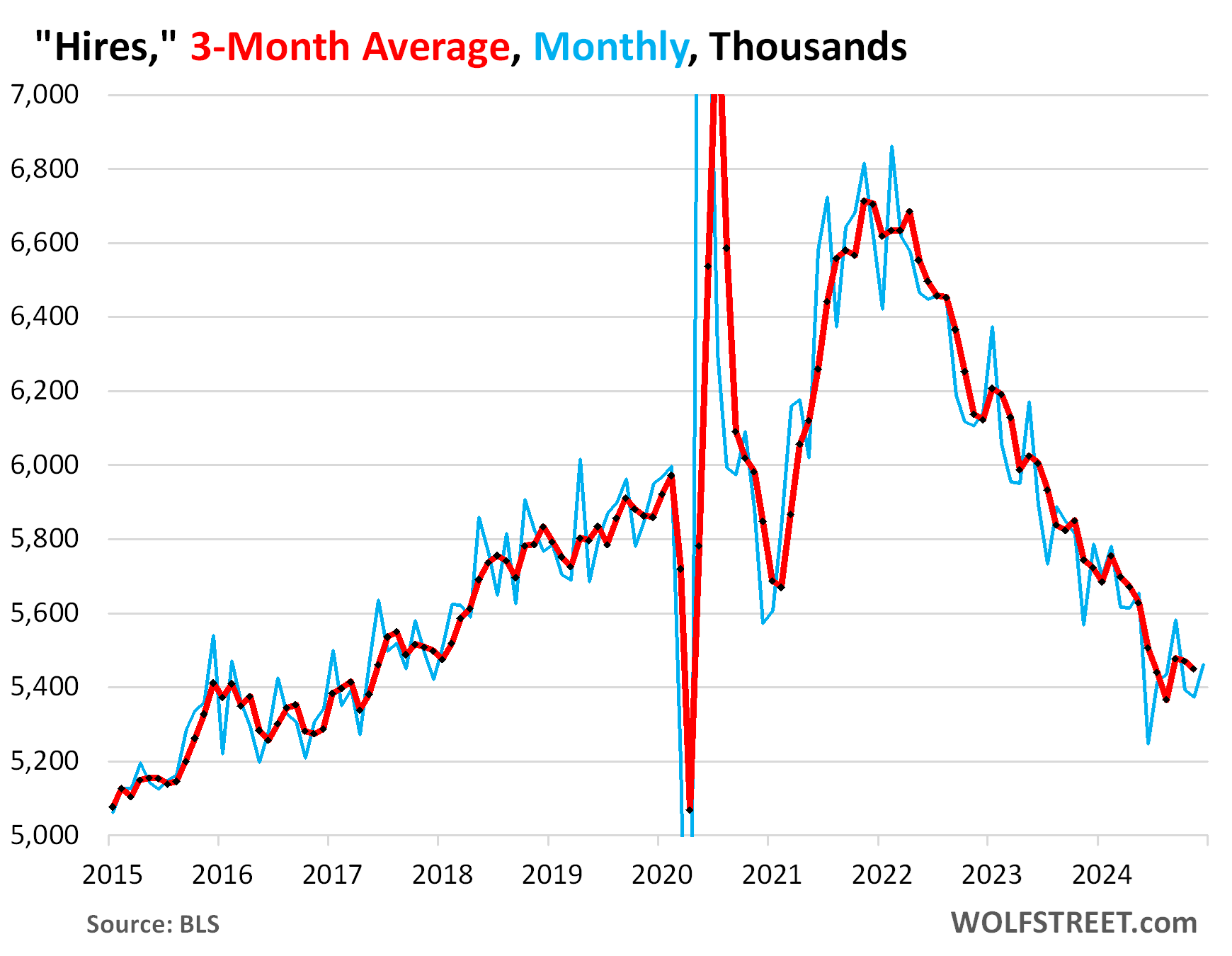
Layoffs and discharges fell to 1.77 million in December. The three-month average also dipped to 1.77 million. They have “normalized” to the low end of the range during the Good Times before the pandemic. Getting fired is a standard feature in the American workplace even during the best times.
Layoffs and involuntary discharges include people getting fired with or without cause. It does not include retirements, deaths, etc., which are in the category of “other separations.”
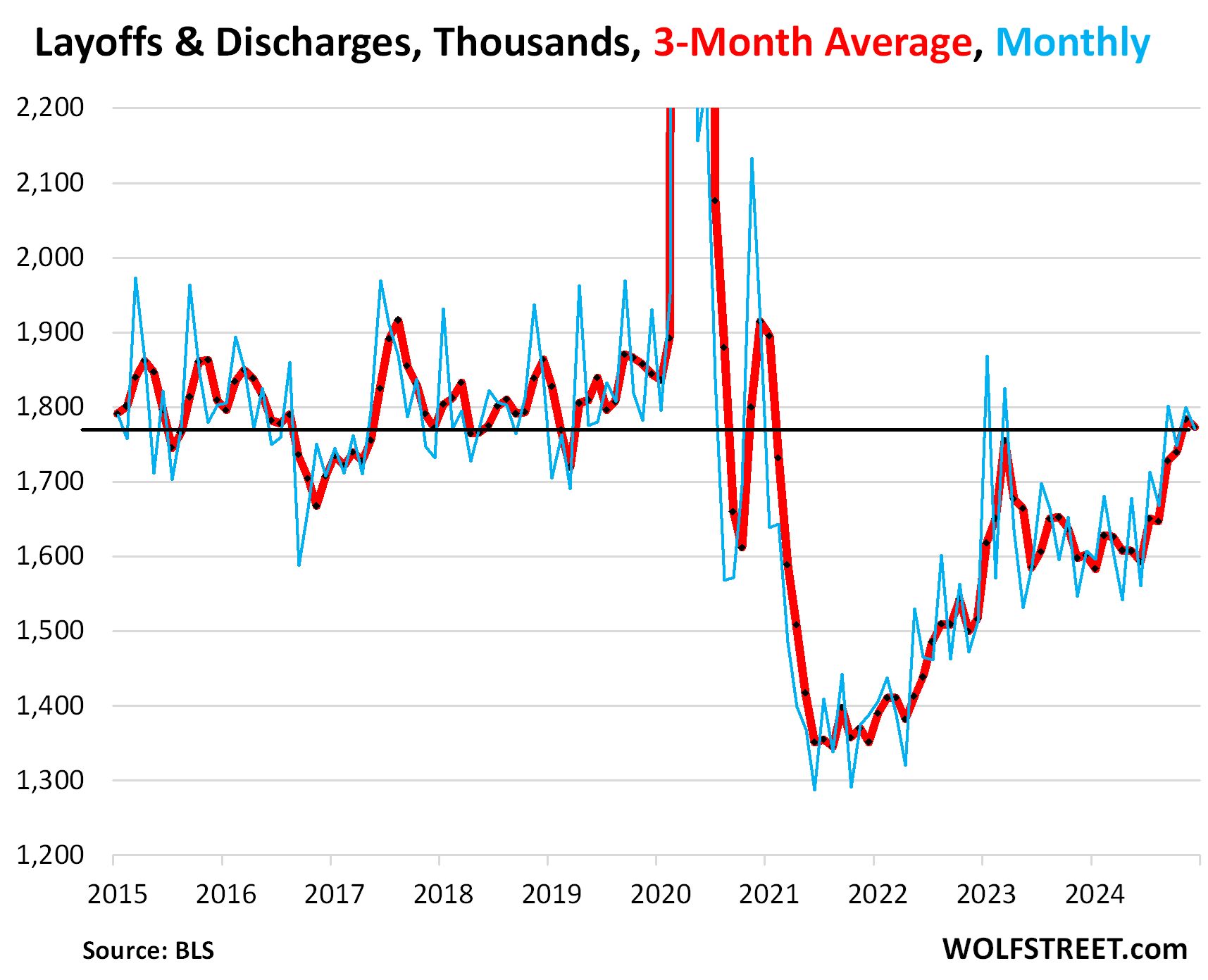
Layoffs and discharges as percentage of nonfarm payrolls, which accounts for growing employment over the years and for long-term views is the better metric to look at, dipped to 1.11%, well below any time during the pre-pandemic years in the JOLTS data going back to 2001.
So, compared to the size of nonfarm employment, layoffs and discharges are historically low, as employers are hanging on to their workers.
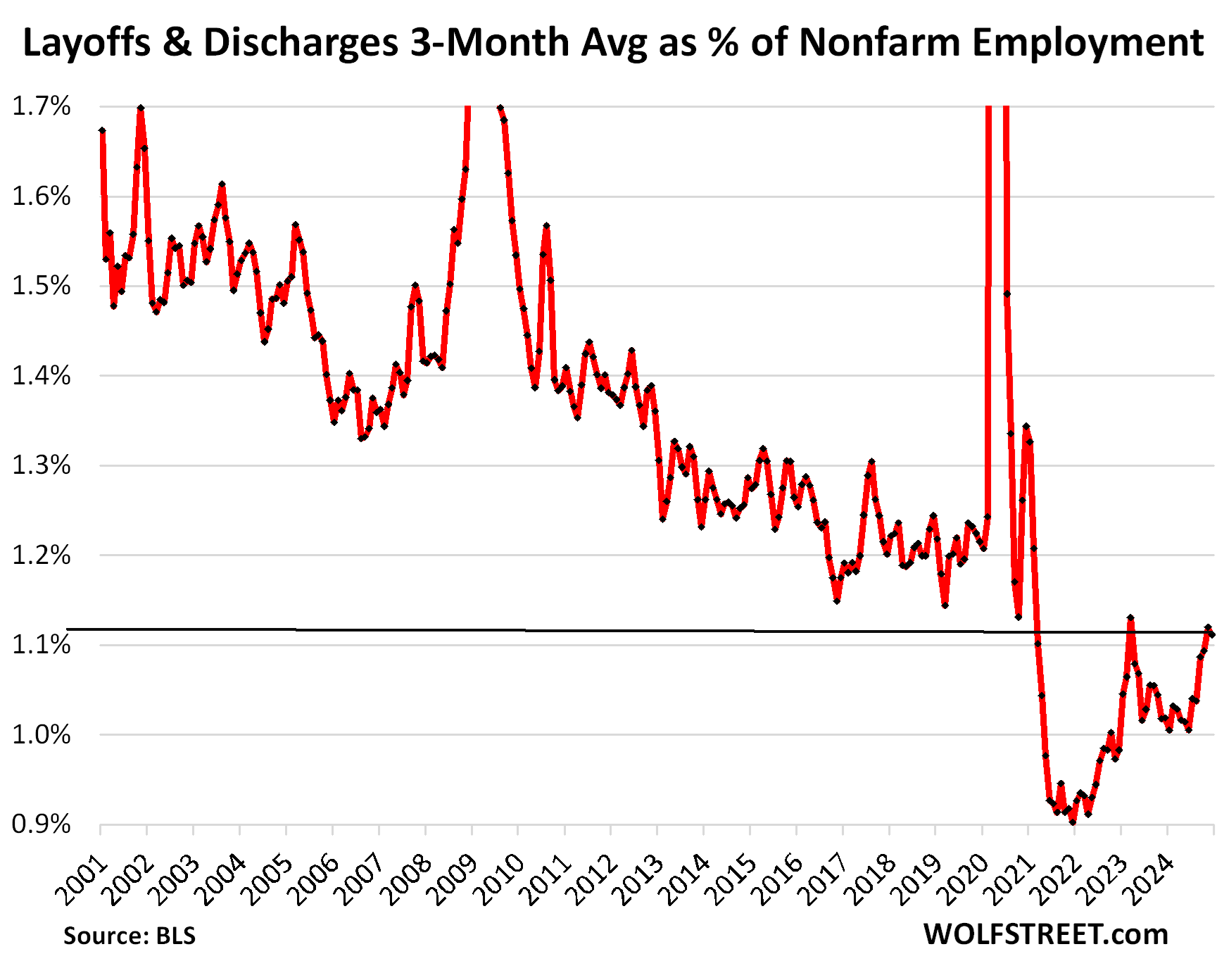
Enjoy reading WOLF STREET and want to support it? You can donate. I appreciate it immensely. Click on the mug to find out how:
![]()


The DOGE guru, Musk, is planning to churn the labor market by force. He wants Agencies to fire all their employees and have them all re-apply for their jobs. This will get rid of all the deadwood, and make the agencies meaner and leaner.
The 1,500 USAID workers who were WFH were told not to come to work. The offices in DC were shut down.
From “I’m from the gov’t and I’m here to help.”
to
“I’m from the gov’t and I need a job!”
As soon as a government worker gets a job, he stops working.
Trite and quaint, but fundamentally untrue. I’m a government worker and I work my ass off, as does every other person I know who work in government (mostly DoD). Maybe this kind of thing is true of the upper echelons, but not us worker-bees.
I personally know .gov workers and they take their oath and duty very seriously. The 2 people I know are fully aware their job is to serve the people by doing their job without bias or politics. Shame some segments in society constantly vilify these citizens for doing their job, especially when they are emboldened due to some very powerful people that lack moral compasses.
I agree, Dave. Try not to get frustrated by the people who have these beliefs. It’s those in power and the media who brainwash people using ignorance and fear to vilify good Americans.
Give them a job if they qualify on paper and in person. Make sure the person who hires them is noted, so they can be held accountable if they keep hiring too much dead weight.. And no more pensions, switch them to 401ks, just like the private sector.
I see government workers in these comments are pretty sensitive about my comment. If they are such great workers, they should get jobs in the private sector where they will likely be paid much more, and usually but not always rewarded for great work. But they will have less job security. No more lifetime jobs living off the taxpayer’s hard earned money. No more getting automatic raises each year with no increase in production.
Oh well, Trump seems to have a solution for government workers that they will not particularly like. It looks like the lifetime job security that government workers crave is disappearing.
Whoa. Dave, Zaridin, et al. I spent my entire work life in the colossus as a customer (military), contractor and GS.
You are correct that there are many dedicated employees who work very hard. It’s a message I try to communicate to the more extreme MAGA types I know who want blanket firings: not fair, not justified, big cost to the taxpayer.
That said, the system isn’t the idyllic environment some picture.
– my sample set across multiple orgs and friends (some in senior gov’t positions) is that HR departments are, on balance, untrustworthy (family relationships, undocumented resume “preferences, etc.)
– there were far more “power couples” in gov’t than other environments I worked in
– there were far more generations of family handing off gov’t work
– there were far more insular groups of 2s and 3s working together to achieve the next promotion on the ladder (with 15 at mid-30s to a bit older being the ultimate goal) and then pulling their friends in with advance info on new job openings
– I saw more senior gov’t folks deciding their cabal of favored contractor support and ensuring their company won re-competes/follow-on contracts
– I rode on golf trips where senior corporate types were on the phone explaining to 00 what congressman so and so wanted
So, you’re right. There are high value people in gov’t. People who have mastered their fields with invaluable expertise. There are also a lot of slugs and low talent types protected by the system.
Federal gov’t is gonna take its hits. It has grown too large. It sat on its collective hands while a lot of questionable, if not outright criminal actions took place. It was weaponized against political opponents.
The people damaged by all of this are very, very angry.
It’s my fear their apostles of virtue elected into office will go too far in cleaning house and sweep up the good folks with the chaff.
The times we live in. Unparalleled corruption by a lot of venal, largely mediocre people.
Enjoy retirement!
Phillip, thank you for sharing your experiences. Like everything, lots of nuance, and the truth seems to be somewhere in the middle.
I had a couple of jobs at the County level in Santa Barbara and as a surfer thought I had landed my dream job living at the beach as a park ranger. 2 years later I was out on my ass for not participating in the endemic corruption that was built into the Department. Not only me, but the two other rangers I worked with were sent packing as well(one, of Hispanic ethnicity, had been the Santa Barbara County employee of the Year 2 years prior). One of our major sins was that we worked on Park maintenance projects on out time off. That was the excuse to purge all three of us. When summer arrived and visitors proclaimed the park had never looked so nice we were gone in 60 days.
Federal civil service doesn’t work that way. He would need to do a Reduction in Force (RIF) for that, and that needs Congress. That is why they are doing the generous Fork in the Road with VERA. While news is reporting not many have taken it yet, anecdotally, it seems like a lot will jump on it. For my agency, the VERA (early retirement) was just announced this week and information is being released now. I suspect that played out at other agencies, too.
Don’t get me wrong, there are plenty of games that can be played to drive people out, but the layoff option above is not one of them.
Keith, uh, I read 20,000 bureaucrats have already accepted Trump’s severance package. Is Congress going to force them back to work? Is Congress going to force the government to hire 20,000 new workers to replace them? I sort of doubt it, since both Houses are controlled by Republicans.
Buyouts are not layoffs, or a RIF in the federal parlance. What Trump is doing is very smart, and with the quick follow through with OPM, many skeptical people are opting- I know a few.
There are big differences between layoffs and buyouts. The issue of eliminating those positions, that would be a fight between POTUS and the Congress. And just because this Congress and POTUS wants to eliminate spots, the next may have different ideas. Look at what happened when Trump move Interior, Biden moved it back while keeping the new site. Sadly, bureaucracies grow as governments/countries age.
All it takes is a budget cut.
It’s amusing what is going on with Musk and all the orchestrated blathering on TV today from the usual set of characters using the old playbook.
True, USAID moneys are Congressionally appropriated. Executive branch can’t just reroute it. That said, the executive has large plenary powers for personnel and can eventually kill the budget in concert with Congress – that’s what is coming next. To this point the executive has frozen payments – after solid evidence of how rogue the agency has become in terms of spending taxpayer money. The executive may win or lose the immediate firing aspect – but in the end will get what it wants.
Appropriations law/regs are unique beasts. Regardless of party, Congress typically protects its turf, and spending power is reserved to the Congress. Executive employees have been prosecuted for spending outside of what Congress authorized, ie violated the Constitution. For examples of how petty can be, look up federal/military purchases of bottled water, something Congress forbids.
Keith, layoffs vs buyouts, they accomplish the same thing, a reduction in the number of employees. It’s like you can go the hard way or the easy way, but in either case you are gone,
Musk does not have the power to do that. The courts will stop him.
He already has
Lower courts might stop him. But the Supreme Court is in Trump’s back pocket, as is Congress. Good luck.
We’re still paying them… scare tactics are expensive and the mandated work is still there…
Corporate reorgnizations or mergers everyone has to reapply for jobs and not just “their own” job up to 5 different jobs. Then offer targeted buyouts and watch the fun begin. All part of real business. All exempt employees have zero protection. Tick tock federal severance expires 2-6-2025.
If you are found improperly documenting hours worked or spending then you are GONE.
Trump team has been working hard the last 4 years with actions plans ready to implement.
Bribem clowns provided a view of D party criminal cartel.
The current hearings for new Trump appointments make D party look more incompetent and just stupid. Liz, Chuck and other D senators have killed D party for the next 100 years.
The emergence of Elon Musk, making mockery of the concept of America
Seems to me more like a return to 19th century America. Ruled by industrial barons and monopolists. The parallels are interesting. In the 19th century, the rich and powerful owned the factories and transportation. In the 21st century, the rich and powerful own the information factories: Twitter, Trump social or whatever its called, Washington Post, Facebook, Instagram, etc.
Just FYI
From NYT:
Democrats were buoyed on Monday by a new report from the Congressional Research Service, which determined that Mr. Trump did not have the authority to order structural changes to the agency without congressional approval.
“Because Congress established U.S.A.I.D. as an independent establishment (defined in 5 U.S.C. 104) within the executive branch, the president does not have the authority to abolish it,” the report states. “Congressional authorization would be required to abolish, move or consolidate U.S.A.I.D.”
All this stuff is just for headlines, it’s illegal and will be stopped and reversed. What a waste of the little time you have left in this world …
Maybe take a walk, smell the fresh air, think about your grandkids. Oh no? You want to hate till your dying breath… ok
They destroy it to fast AND defy court orders. What does it matter if it’s illegal if the project got cancelled, the people let go forced to return to the US and equipment sold of?
You are not reversing the destruction in 2 years.
Maybe.
Or maybe this is all part of a deeper plan to cut off USAID Congressional funding.
There’s always multiple paths to a solution.
USAID is an agency. They come and go.
Problem with the JOLTS is all the phantom positions that don’t exist and multiple entries of the same job posting across state lines. If we removed this glitch in the system we’d see probably .5 openings for every 1 unemployed or somewhere right around there. And don’t even get me started with the archaic BLS figures that come out each month.
Ignorant BS. RTGDFA. What does it say in the article?
It’s “based on surveys of about 21,000 work locations, and not on online job listings.”
DOGE makes for good headlines but a lot of these folks are either union or management organization protected… it’ll be playing out in the courts for a while.
There are well over a dozen wildly illegal things this administration has done in their first two weeks, which taken together create a constitutional crisis. How it all plays out is anybody’s guess.
No worries Sandy. AOC is on it. She’s already informed us that she’s wildly more intelligent than Elon Musk when it comes to government administration.
@Slick I agree this will be in the courts for a while but I think we will all be better off just paying most Government employeees to stay home rather than letting them “work” (a couple houed a day from home) spending our tax money and thinking of new things to tax and regulate.
If work isn’t happening at home, why would it happen in the office? Productively and quality can be measured. If it is not, that is a management issue that needs to be addressed, not a location issue of the employee.
Well said. I’m a state employee working a hybrid schedule and I’m tired of the automatic assumption of lessened productivity.
If management is doing their job (and I don’t hear any evidence they’re not), then the federal employees are doing theirs as well.
So, it’s a bit of a stretch to just assume everyone working from home is just sitting on the couch all day eating bomb bombs.
in my experience, most government employees aren’t doing much work whether they’re in office or not.
why would they? there are no consequences to screwing up
My dental hygienist was complaining about her employer not allowing her to work from home yesterday.
There’s a lot of people who either were never trusted to work remotely, or have poor enough work ethic themselves that they can’t fathom someone else getting their job done from home rather than an office. Those who have worked in competent hybrid environments know it’s irrelevant. As Keith and others have said, it comes down to effective management, which is necessary in any type of work environment.
You bet!
Doesn’t work for classified environments.
Doesn’t work for environments that require substantial support infrastructure (e.g., T&E).
Doesn’t work where infrastructure for software upgrades that have to be done hands on (not over the line) is a requirement.
Has its drawbacks when network reliability isn’t quad nines.
Such interactions work in some contexts and not others. It’s largely a subset of white collar worker preferences.
It has its opportunity costs – something you fail to include in your buck passing to management.
PJ,
I believe the definition of management is WHO the buck gets passed to.
All the way up…..it is also the justification for their 10-500x salaries…..the pressure of taking responsibility for EVERYTHING actually can kill them….or so they say…….
Agreed Phillip, it depends on the industry, company, and role. Fully remote vs hybrid is very different, too. And while you’re right about opportunity costs, one can also imagine opportunity costs to mandating a return-to-office when it’s unnecessary: office space, employee satisfaction/retention, attracting top talent, contributing to traffic, environmental impacts, etc.
Management is at will employment never protected.
Every day is mundane historic, financial heights never before attained, boldly advancing
I’m just suggesting that the asking price for over priced assets is likely to fall, eventually.
– Mr. Market agrees that there will no rate cuts but also no rate hikes.
I currently think that the Fed is caught between a hard place and a rock. The world turns around every day,
I agree with the Fed decision to hold pat. The fire works are yet too come.
I commented yesterday that if it turns out that rates stay exactly where they are for the next year, two, four then I’d be perfectly happy. Getting around 4.5% on money short or long while inflation sits between 2 and 3%.
If dropping rates is wrong and raising rates is wrong then the Fed will do nothing.
I was talking to a friend who runs a temporary staffing business and they explained how the industry is faring really poorly. This is also evident from the reported results of large temp staffing companies such as Kelly Services, True Blue etc. Healthcare staffing is also another example where there has been massive hiring cuts.
At the same time there are a large number of open positions. Likely that the pandemic disrupted the labor market significantly. People seem to be where there aren’t job and jobs seem to be where there aren’t people or there is a skill mismatch.
Likely going to keep putting upward pressure on inflation.
Wolf is there a source to find data on job data by sector?
Yes, the JOLTS data is by sector.
Just before I left the government to retire we were forced to work in the office 40 hours/week plus 20 hours per week at home. When I told my boss this was illegal, to work 60 hours/week for 40 hours pay he told me that everyone else was working 60 hours and called the extra hours “casual overtime”. He said if I didn’t take the training on my own time, on my own computer, using my own Internet, I would get an UNSAT performance appraisal. He meant business. I told these b$stards to go f$ck off and retired with full benefits. How things have changed. Now we have many federal workers , 4 years after the pandemic ended, doing absolutely nothing and working another job on their laptops and drawing two salaries.
I think that the best architecture of life, is blessed chaos.
I see you are still using information sources that take advantage of you and make you look silly.
Do better. You are ruining the country by lapping up misinformation.
I worked civil service for min time required to reach a minimum pension as a 14 (five years). Hated it. The politics ran thicker than blood. Worse than military. Worse than corporate world.
That said, there were good people in gov’t service. And there were bad people.
Agree that your supervisor was a class A rectal orifice. Glad you got away with the dubious digit approach!
I have seen the other side where civil servants refused to do some work and challenged management to do anything about it. The system is designed to favor employees to the degree it could take upwards of two years to document non-performance leading to a termination. Best that could be done was to move such people to pointless jobs in East Bejubus.
You lies make me want to respond, but considering what’s going on way above your little gated (or well policed) conmmunity level…..it’s not worth it.
I will be deleted for delivering the cordiality you apparently deserve anyway,
If I hated a job I quit…made a good show of it if I could, for those miserable and stuck there……..Military?….forced in…..can’t quit……was bad job, too…….
One wise man has this opinion: .. .. ” You may have seen that the statutory debt limit was reinstated on January 2, 2025, at $36.1 trillion. One of Bessent’s first acts as Treasury Secretary, assuming he gets confirmed, will be to suspend debt issuances and to take extraordinary measures to shuffle money between accounts without breaching the debt limit. Once Bessent gets past the politics of the debt limit he will face a relentless wave of nearly $3 trillion in debt that’s expected to mature in 2025. This is on top of the likely $2 trillion deficit. All this debt will need to be financed at interest rates that are much higher than just several years ago. This will further blow out Washington’s budget (and will likely trigger a credit crisis and panic liquidation). That’s when the Fed will crank up the printing press. Before it’s over, the Fed’s balance sheet will push upwards of $15 trillion. The dollar, in return, will be the sacrificial lamb…as will Bessent, as he’s run through the meat grinder.”
Well, maybe. That’s what gold seems to begin to be saying…
…BUT, as Wolf has documented, The Fed has taken the balance sheet to under 7 trillion, something I thought they would do (gla Wolf didn’t take my bet), HOWEVER, they still have all those MBS, which is complete bullshit.
should read “wouldn’t do”.
I am a little surprised that the Fed hasn’t stepped in already.
DM: America’s biggest employer to cut hundreds of job and close major office as part of new strategy
Walmart, America’s largest private employer sent a memo to staff members Tuesday saying it is planning to cut hundreds of jobs and close its North Carolina offices.
It’s funny: An employer with 2,100,000 employees relocates some people from small offices (to close those offices) to its headquarter in Bentonville, Arkansas, and to its hub in California for greater efficiency and team work, and lays off a few hundred people in the process, while hiring many others in other locations, and it’s like global news of the collapse of the labor market? Clickbait stupid headlines really work! People click on this shit and spread this shit. That’s why clickbait exists.
And social media is click bait on steroids.
Somehow having a Fed that can be “spooked” (Wolf’s word) does not inspire much confidence. No wonder the Treasury bond market (20 year) is approaching a 5% yield. The Fed has lost all credibility. I watch Jerry “Mr. Deadhead” Powell’s press conferences more for amusement than edification. He is actually pretty funny, even though he does not mean to be.
As if a 5% yield is punitive. Risk is about to make it’s debut, again, when the excess bank reserves collecting interest in the Fed’s digital vault aren’t pledged as collateral for an anti-social scheme.
My wife’s cousin works for the CIA, voted for Trump, and just received a buyout letter. the look on his face was priceless.
US 1-MO
4.304
US 2-MO
4.319
US 3-MO
4.32
US 4-MO
4.323
US 6-MO
4.303
US 1-YR
4.164
US 2-YR
4.172
US 3-YR
4.195
US 5-YR
4.243
US 7-YR
4.337
US 10-YR
4.432
US 20-YR
4.717
US 30-YR
4.662
Not quite 5% on the 20 but close. Otherwise flat as a pancake. Mortgages will DROP with the ten year down to 4.4..and housing will look better..
.gov processed a million job applications today. Master’s w/ Certifications galore. There’s still a few slugs left. They’re staying put!
Eventually President Trump and Musk will take over the Fed and gut banking regulation. Part of the Golden Age plan.
Why don’t they just say “Gilded Age? Same thing and nobody remembers it, anyway.
Guess his speechwriters are taking NO chances.
Trump and crew can and will make all sorts of cuts of federal employees. They have the right to eliminate positions and will let the courts battle it out over the long haul. But when a federal employee no longer gets a paycheck, it’s pretty much game over for them.
Congress can try and make lots of moves; the reent one being that the executive branch can’t eliminate USAID. OK, reduce it down to 1 employee (token) and keep it “open”. Probleml solved.
Regarding employment situation, Powell is slowing the economy down by holding rates up. He wants to see real softeness in employement as strong employment is the catalyst for renewed inflation (wage demands). It will be a tricky ride though, as I believe things could roll over rather quickly.
The Walmart announcement as Wolf states is more show than go, but it does indicate continuing need by firms to get leaner and more efficient. An anecdotal source for employment monitoring is Jobcuts.com. I’m not promoting just offering as a different source of info.
Mike R., Both houses of Congress are in Trump’s back pocket, or if you like, Musk’s back pocket. Whether this is good or bad depends on your situation. But it is a fact. The lower courts will end up deciding a lot of issues, but there will be appeals, and remember, the Supreme Court is also in Trump’s back pocket. I would say from a very broad perspective, government workers, unless they are very good workers, might want to think about getting jobs in the private sector.
This plays right into the CRE market as the Federal Government will have even more office space to dump into an already soft market!
As far as I can tell, from the salaries I pay my own employees, we are entering the end of the cheap labor era…
Now openings are decreasing and people in government and the private sector are being let go. Are all these people going to suddenly get trained and hired into a new manufacturing plant somewhere? I don’t think so. Interesting times.
If ALL of the USAID employees lose their jobs today, and they’re ALL looking for new jobs (unlikely since a bunch will just retire with full benefits), that will add 10,000 people to the 6.89 million people currently out of a job but looking for a job. So it’ll get lost as a rounding error. If these people are not in your area, you won’t notice a thing.
When would you begin to think that the plan is to remove a large portion of the government workforce would kick in (USAID, CIA, Department of Education…)? Seems like daily we hear about new components of federal system being shuttered. Do you think these will cause more cascade effects? In the big picture if we have mass deportations (job losses, car loans not being paid, empty properties and knock on effects) could you see a point when we roll-over and have a bigger problem?
To be honest, I am amazed that the CRE crisis hasn’t blown up banks yet, but I guess we are still using “mark to fantasy” accounting. I believe George Carlin said it best; “It’s a big club”
OT:
Given all of the knee jerk activity in the markets from The “Daily Headlines”
the VIX is elevating.
Gold has made a run at $2,900 overnight and the dollar remains relatively strong just under 107.5 as I write. Gold has been on an upswing and the mining stocks have mostly doubled over the past year.
Is all the instability from regulatory change pushing dollars into gold and mining stocks?
Where is all this strength coming from?
Wolf, please feel free to delete this comment and thank you for all of your insight into subjects I would not otherwise contemplate.
Central banks and sovereign wealth looking for “safety” and not choosing treasuries or government debt. Essentially, government debt being avoided or even sold for gold. A tier one preferred asset/collateral. I saw something about physical demand as well. Think it was a WSJ article. Gold moving out of London to New York and Beijing…
Interesting times.
“not choosing treasuries or government debt”
Yet yields have gone down in the last week not up…
Gold, crypto, tulips. None have much intrinsic value (crypto has none). Just more mass delusions. Of course, some people have made a lot of money from the madness of men.
LMFAO! Physical gold is NOT crypto. Physical gold is still THE preferred collateral around the world.
As a side note, I have paid for services (plumbing, electrical work, painting) with precious metals. So your comment about gold/silver is horseshit. All tax-free as well.
Want good investments: try gold and farm land. The rest is just paper
Farmland prices between Grand Forks and Canada are staying strong even though ag commodity prices are low.
29 January 2025, from Red River Farm Network:
“Pembina County Farmland Price Remains Red Hot”
“Despite a stagnant farm economy, good quality farmland values remain strong. Pifer’s Auction and Real Estate cite two quarter-sections west of Drayton, North Dakota in Pembina County. One parcel brought $11,550 per deeded acre or $1.8 million total. The second parcel of 160 acres sold for $10,350 per acre or a total of over $1.6 million.”
Many commodities are subsidized. Take those subsidies away and prices would go up. There is a farm subsidies database where you can go look up what a specific farm receives. I know of a milk farmer that over the past 10 years received over 1.3 million. The covid year of 679k sure helped bump it up a lot though.
In total, the federal government paid more than $478 billion from 2015 to 2021 in farm support for crop insurance, disasters, conservation payments and subsidies for certain crops like corn and soybeans, according to the analysis of federal data the Environmental Working Group released Wednesday.
The last time the farmland bubble imploded, it caused huge damage, took down lots of specialized banks, and left many overleveraged farmers impoverished. When hedge funds get into something like farmland, you know it’s going to implode eventually under its own speculation and weight.
Absolutely, just like metals and agriculture to get to the party last, and crash hardest. Remember when it happened last time? And the time before?
So at $11k per acre in NoDak, you get 56 bushels of wheat gross x $6 per bushel= $366- net probably $110. So, you pay how much to earn a 1% net return? De maths, dey hard.
I am simply amazed that any hedge fund who talks about farmland has any funding. I guess they just can’t find anything worth buying in this market. Except gold. Welp, they were all buying just before things fell apart last time.
They used to be the smartest money in the room, but now, meh.
Part of what hedge funds are now doing is trying to get commitments from utilities to provide prodigious amounts of power to the cornfield so that they can sell the cornfield for a gazillion dollars to data center developers. The whole thing has turned into a complete racket.
At least my “paper” (assume you mean Treasuries) pays me regular income. The gold sitting in my safe doesn’t do that.
The gold sitting in your safe if THE preferred collateral of all banks. Leave it for your children to get a loan in once everything resets. Alternatively, there are several investments that hold physical, that you own, that also pay interest.
The gold in my safe is an insurance policy. If I’m using it, it probably means some major crisis has happened which would suck. But in that scenaro I’ll at least be better off because of it.
I have insurance on my house and car too, and those also cost me money.
Insurance is a sucker’s bet.
No, wrong again, PMs are also money, not insurance. I paid a plumber in silver when it was in the mid thirties. Even by today’s prices it was a heck of a deal.
It’s not literally insurance, but it’s like insurance because I’m saving it for rainy day. “In case of emergency, break glass.”
Wouldn’t it have made more sense to pay that plumber in depreciating dollars instead of silver?
P.s. I have a bunch of silver in my safe too.
No irony with the elimination of DEI that most(not all) Trumps cabinet picks have no qualifications to do the job. Makes the idea of hiring the best person for the job argument look like hypocrisy.
Make no mistake, they’re eminently qualified. The job description has just changed.
It isn’t within the power or responsibility of the Federal Reserve to hold unemployment to a given level. In fact, to assume that the Federal Reserve can solve our unemployment problem is to assume the problem is so simple that its solution requires only that the Manager of the Open Market Account buy a sufficient quantity of U.S. obligations for the accounts of the 12 Federal Reserve Banks.
I used to think the Fed wasn’t supposed to be involved in employment, too.
Turns out they have a dual mandate, but they went nuts on it when they held interest rates so low for so long… Trying to maximize employment they screwed up the whole long-term interest rates thing.
Here’s a quick summary from investopedia, but I’m sure you can find plenty of other sources out there:
“ Congress explicitly stated the Fed’s goals should be “maximum employment, stable prices, and moderate long-term interest rates.” These goals, which remain today, came to be known as the Fed’s “dual mandate.””
It will be interesting to see what mass deportations do to the numbers. I would think we would see an increase in the number of openings per unemployed person. Possibly wages going up in those fields that rely heavily on immigrant labor.
“Mass deportations” are nearly impossible to pull off in the US. The deportations now happening of established illegal immigrants (not just those grabbed at the border and sent back) may be in the hundreds a day. In terms of the employment and job-opening numbers, they’re too small to make a visible impact over the shorter term, though it would add up over the long term, and we might see it in the numbers.
But what has already happened is that the crackdown has dramatically slowed the influx of illegal immigrants. This already started under Biden’s soft crackdown in 2024, but the influx is now dramatically slowing down. And those numbers of the people that would have come but are not coming into the US are big. And that’s going to make a visible difference in the numbers this year.
Looking on Customs & Border Protection website, it looks like crossings have leveled out around 100K per month (July thru Dec). I don’t see Jan numbers yet so I guess we will see if they are moving now with Trump in office. And yeah, deportations of people in the US is tough as our Immigration laws allow all due process which can take literally years.
I read, but of course cannot confirm, that many illegals are now self-deporting. Getting reliable data on the size and movement of the illegal population in the US is pretty much impossible, because, well, the illegals are not likely to want to be counted by any pollster or government agency and any estimates by “experts” are just guesses. There are ball park estimates, but these are just ball park estimates.
Why doesn’t Trump mandate E-Verify for all large employers accross the board in the USA. That would solve the problem of these Corporations hiring illegals “off the books” for cheap wages and not paying withholding taxes and other taxes.
Corporate America and rich households with staff, addicted to cheap labor, hate E-Verify.
TOXIC: TELSA SALES PLUNGE IN EUROPE…
-60% in Germany…
That’s what you get, Elon, for loudly siding with, encouraging, and endorsing the AfD (the relatively new right-wing political party in Germany). But Germany is about 3% of Tesla’s global sales. The US is nearly 50%, and California alone is about 10% of global sales. And Tesla sales plunged in California to the lowest since Q2 2022, even as non-Tesla EV sales have soared and more than doubled over this period and have bypassed Tesla sales. Elon is sacrificing Tesla at the altar of political power.
why is the 10 year down 10 bps?
I noticed that too? No clue.
Today the Treasury announced their offering for the 10yr and 30yr at the auctions later this month. Could be a supply/demand factor if the market was expecting more to be offered
I noticed that too, but there did not look to be any surprised in their schedule.
Longer-term yields have been dropping ever since the Fed started taking the re-acceleration of inflation more seriously and has pivoted to wait and see. A hawkish Fed is encouraging for the bond market. Inflation is anathema for the bond market.
Affirm reports after the bell. It will be interesting to see if the consumers are increasing spending and debt. Also it will be interesting to see if there are any late payments.
I found data at BLS for “other separations” (300,000). I can’t find data at BLS for “other discharges”, which appear to be “for cause”.
That’s correct, retirements are in “other separations.” I used the wrong word. Thanks.
The glee that some folks have other folks possibly losing their jobs or being harassed by a corporate no one voted for is not a great look for their team.
It’s like the focus on SNAP, cutting people off from from health benefits, etc. Bullying poor people or civil servants doesn’t do it for me. But then I am not a loser looking for excuses at my lot in life, so maybe that’s why I don’t think it’s cool.